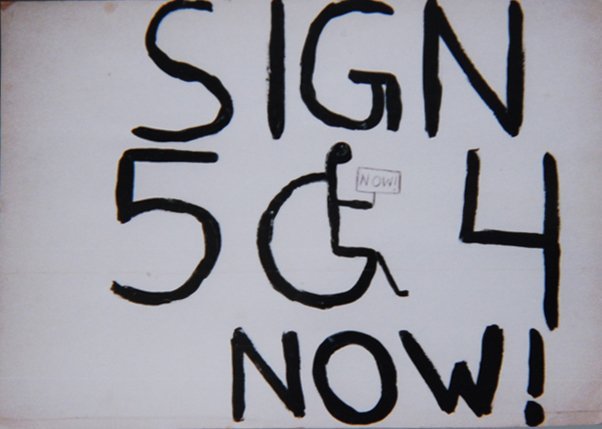Nothing About Us Without Us: A History of the Disability Rights Movement
Content Warning:
This article will make mention of abuses and murder of Disabled people as well as the eugenics movement. If you are Disabled and need to care for yourself, you may choose to skip this one. If you are not Disabled, I ask that you find the energy to engage with this knowledge.
Disability in History
Our modern minds assume that history has not been kind to those who are disabled, but this is not really as true as we believe. While there has definitely been times or places in which Disabled folx were harmed, institutionalized, or murdered throughout history, there is also growing evidence of Disabled folx being loved and cared for by their communities. There is evidence of ancient humans caring for their Disabled community members throughout history, going back as far as to our close relatives the Neanderthals.
However, our modern understanding of the history of Disability is shaped by the eugenics movement. Eugenics grew out of the movements surrounding and enmeshed in what is now known as scientific racism (you can read one example here in Thomas Jefferson’s own words). This movement grew in popularity and shaped the 20th Century to the point in which the Nazis looked to the US, particularly California, as inspiration for their own eugenics movement.
While there have been Disability Rights activists since at least the 1800s, the modern movement began in earnest right on the heels of this attempted genocide and aligned with the Civil Rights movement in the United States.
The 504 Sit-Ins
Image via the Smithsonian.
While benefits and rights for Disabled veterans began to become codified after the world wars of the early part of the 20th Century, on the whole there were few benefits or protections for Disabled civilians. At the time, in the wake of the slowly-receding eugenics movement, children with disabilities were still not welcomed in neighborhood schools and adults with disabilities struggled to be taken seriously as creative, competent, successful members of the workforce (1).
I want to take a quick break from the narrative to attempt to exemplify something extremely important. At a time when the idea of “separate but equal” was decried across America as the discrimination it inherently is, this was still a totally acceptable concept for the education of children with disabilities. People could flip in an instant from (rightfully) demanding equitable education for all races to tripping all over themselves in order to excuse the separation of Disabled folx from abled without ever seeing the irony. This is still prevalent today. I am in no way advocating the raising of the Disability Rights Movement above other social justice movements; I am calling to action all those who believe in equity to make a point to give the same time and attention to the Disability Rights Movement as we have to other social justice movements. Keep your eyes open.
By the 1970s, as the Civil Rights Movement was cooling, the Disabled community was still struggling to obtain equity. In 1973, the Rehabilitation Act was passed, but two presidents neglected to act to sign it into law. By 1977 when Carter was president, it became clear that the administration was working to water it down and weaken it. Disability activists knew they had to act immediately (1).
Image found here.
During the next 25 days, approximately 150 Disabled activists staged a sit-in on the fourth floor of a federal building in San Fransisco (2). There were smaller sit-ins across the country as well, but they did not last as long - likely because they had less support. This was a physically demanding situation for the people involved, many of whom suffered with the bare accomodations associated with protesting (2), but they were supported by other communities. The Black Panthers made sure everyone was fed, and the mayor of San Fransisco had mattresses delivered to help ease the physical suffering (1), but “many went without the care of attendants, or back-up ventilators, catheters, or other necessary equipment,” and some also experienced exacerbated symptoms or conditions during and even beyond the sit-in (2).
The sit-in also meant a loss of privacy. "Every morning," one demonstrator remembered, "you could come across people involved in various forms of personal care activities and in various stages of dress and undress (2)."
Where sit-ins are hard work for anyone who participates in one, having a body that does not work in the same ways as most bodies work makes such a situation all the more serious, and sometimes dangerous.
But it was rewarding! Judy Heumann, one of the leaders of this movement noted that "At the start of our demonstration at the HEW offices, officials treated us with condescension, giving us cookies and punch as if we were on some kind of field trip (qtd in 2)." But then, "Through the sit-in, we turned ourselves from being oppressed individuals into being empowered people. We demonstrated to the entire nation that disabled people could take control over our own lives and take leadership in the struggle for equality (qtd in 2)."
Of course they were! People with disabilities are just people, and like all people they have varying capabilities and a wealth of creativity and intelligence in the community as a whole. It’s time we start expecting such a thing and not being surprised by it.
By the way, Drunk History did this story and my understanding is that the Disabled protesters were played by Disabled actors which is awesome representation. You can watch it here!
Deaf President Now!
Gallaudet University, founded in the mid-1800s, is a historically significant school for deaf and hard of hearing students from preschool through graduate school. In 1988, the school’s sixth president was retiring and it was time to elect a new president. At the time the school had never had a deaf president and the community was hopeful that one of two qualified deaf candidates would be chosen by the board. Instead, the person who was chosen was not only hearing, but also did not know ASL (American Sign Language). Students were righteously outraged and began protests (3).
On the first day of the strike, 500 students set out to shut down the campus after a stormy meeting with the university admmtstration. While the school remained open, students claimed that 90 percent of the campus community participated in the strike. Campus entrances were blockaded with shuttle busses after the tires were flattened. The faculty voted 147 to 5 to back the students. (3)
Photo found here.
The movement culminated with a march on Washington attended by 3,000 protestors from across the nation. The Crispus Attucks Museum loaned the group a banner reading “We Still Have a Dream” which had originally been used in a movement to get Dr. Martin Luther King’s birthday decreed a national holiday.
On Sunday, March 13, 1988, Dr. I. King Jordan was elected the first deaf president of Gallaudet University in the 124 years since the school was founded (3).
The Capitol Crawl
Jennifer Keelan, 8 years old
Nearly exactly two years later, on March 12, 1990, the Americans with Disabilities Act was making its way through congress to become law. But when things abruptly slowed down, activists became concerned that things were being changed that would weaken the laws. One major complaint was the concern that local municipalities would not have the financial resources to do all the upgrades and make sure all public busses and trains would be wheelchair accessible (4).
(See now, if they’d just been inclusive from the outset, they wouldn’t be in this bind now, would they? Progress will happen. You will save money, time, and energy in the long run if you work to be inclusive to all from the beginning. Just FYI.)
On March 12, about 1,000 activists arrived at the Capitol building in D.C. to protest (5). After a speech, dozens of those in the crowd at the bottom of the stairs discarded their mobility aids and climbed the stairs to the top, many of them dragging themselves up, step by step. Jennifer Keelan, the youngest protester there at 8 years old, took nearly an hour to get to the top. Some have critiqued this movement as being too “undignified” but that’s the whole point. It’s undignified to not have access to things. It’s undignified to not have accomodations. Most days, folx will turn around and go home. This day, they showed what it really meant to not have accessibility.
But are we moving backwards or forwards?
Photo from Vox.
In 2017, Disabled protesters once again gathered, this time outside Mitch McConnell’s office to protest cuts to the new healthcare bill. In this case, police physically lifted people out of their wheelchairs to remove them from the property and arrest them (6). Talk about undignified ffs. Maybe definitely remember to check out my post about ACAB next. geez.
Today and Tomorrow
One of the biggest “reasons” why people fought so hard against accommodations was the idea that people with disabilities were so rare, it didn’t really matter when designing cities. The obvious problem with this line of thinking is that even if there was only ever one Disabled person, do they not also deserve the ability to take a bus, to interact with the government, to attend school with their peers? Making the world inaccessible is unethical, period.
But the number of people with disabilities is estimated by the WHO to be 1.3 billion people worldwide. This is about 16% of people. That means if you know six people, one of them is likely to have a disability.
The problem is that when the world is not accessible, Disabled folx cannot access the world and so you won’t see them out in the world. It is a self-fulfilling prophecy. But just because we aren’t visible does not mean we don’t exist.
What can I do?
One thing you can do today to help your local Disabled community is to continue wearing masks when in public. Disabilities tend to come in collections rather than just one disability at a time. When something in a body is not working typically, other systems may also not be working typically either because the one affects the other or because both are caused by the same third factor. But many Disabled folx are immunocompromised meaning they are at even higher risk of COVID and long COVID than abled people. As the world drops prophylactic measures against the virus, this means Disabled folx will get more trapped in their own homes and have less access to necessary and joyous things outside their homes. By continuing to mask in public, not only are you continuing to protect yourself from COVID and long COVID (this is a mass disabiling event, btw), you are also sending a visible message that you stand with the Disabled community.
Another thing you can do is to follow Disabled creators, and listen to them, learn from them, and then take that knowledge back to your own communities. By following the community you can stay abreast of future needs you can ally for while also learning more about the Disabled experience.
If you’d like to help me to continue doing this work here, you can find multiple ways to support me here. You can also choose to buy this sticker, featuring the phrase “Nothing about us without us” on the Disability Pride flag.
Sources:
Crip Camp, documentary on Netflix.
National Museum of American History, “Sitting In For Disability Rights: The Section 504 Protests of the 1970s” https://americanhistory.si.edu/blog/sitting-disability-rights-section-504-protests-1970s
Smithsonian Institution, “The Gallaudet ‘Deaf President Now’ Movement” by Jacqulin C Peters https://folklife-media.si.edu/docs/festival/program-book-articles/FESTBK1990_20.pdf
WETA Public Media: https://boundarystones.weta.org/2021/09/16/capitol-crawl
History Channel on the Capitol Crawl: https://www.history.com/news/americans-with-disabilities-act-1990-capitol-crawl
Vox “‘No Cuts to Medicaid!’ Protesters in wheelchairs arrested after release of health care bill” https://www.vox.com/policy-and-politics/2017/6/22/15855424/disability-protest-medicaid-mcconnell







